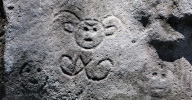| Kaz | Enfo | Ayiti | Litérati | KAPES | Kont | Fowòm | Lyannaj | Pwèm | Plan |
| Accueil | Actualité | Haïti | Bibliographie | CAPES | Contes | Forum | Liens | Poèmes | Sommaire |
|
Clever Bouki Illustrated by Steve Aldeus |
 |
Comments by Bob Corbett with gracious help from Anissa and Hannah Sharamitaro. December 2010
Nekita Lamour is a long-time acquaintance of mine, a woman living in the Boston area of the U.S. but from Haiti. In Haiti perhaps the most dominant figures in folk tales are Uncle Bouki and Ti Malice. Bouki is almost invariably a bit of a dunce, lazy, often, when pictured, he is a bit dumpy and sloppy. Ti Malice is a bright brat, and usually takes advantage of Uncle Bouki in some measure.
However, Nekita Lamour, while seeming to aim at a Haitian audience, doesn’t appeal to that tradition but sets the story in Dahomy, Africa (from which many ancestors of today’s Haitian families set sail in chains as slaves for the colony of Saint-Domingue).
In this story there is no Ti Malice, only Bouki himself, seemingly much younger than in Haitian folk tales, and incredibly brighter and “together.”
Nekita sent me a copy of her book, a colorful typical looking book for young children about an 8x10 size. I read the first page and stopped. I liked what I had read, and it set the stage for the story, but I didn’t want to read more yet. That first page reads:
Once upon a time, a great king of Dahomy, West Africa, King Atu, decided to have a contest. He invited every one in the country. He was going to throw a ball up in the air. “Whoever counts to hundred (100) before the ball hits the ground, will receive half of my fortune,” said King Atu.
I decided to seek some expert help in testing out this story. At our Corbett family Christmas gathering on the 25th I sought out my son, Joe, librarian for an elementary school here in St. Louis. Joe reads more than 200 children books a year and suggested I actually read the story to some children and talk with them about the book. I liked the idea. But, the Corbett gathering is no place for that! With 18 grandkids and a significant spate of collateral relatives, and all my kids and spouses, well, it’s 50 or so people and a bit of a happy happy madhouse!
However, one of Joe’s sons, high school boy, said, “Papa, what base are they counting in? A base of 10 wouldn’t be too hard.” I looked at Riley with some surprise and thought, why in the world didn’t I think of that, but surely that can’t be where Nekita is headed. Ha, little did I know.
Later Christmas Day we were going to be with just two of my partner’s Sally’s kids and their children, so this would be a much smaller gathering, and two of the grandkids, Anissa, age 7 and Hannah, just short of 6, were just the right age.
I told their father, Dave, what I was going to do and he suggested that I have Anissa do the reading, then we discuss the story, and that’s how it went. The three of us went off to a quiet place, and Anissa, with marvelous expression and vocal comprehension read the story. Hannah, sitting next to me as well was gripped with her sister’s rendition. The name “Bouki” did throw Anissa a bit of curve, and Dahomy, Africa was a new place for the girls, but otherwise, we zipped through the story with delight.
It does come out that counting the normal one, two, three . . . gets people no where since the ball hits the ground before they get along at all. So, some of the people in the king’s realm do begin to count by other bases, 5 and 10 come to mind. But still, no one gets to near 100. Bouki, however solves the problem with a rather astonishingly clever counting and not only gets the wealth but the king’s daughter in the bargain. Not much was said about the king’s daughter, however, so we’re not too sure what a prize she was.
The girls really liked the story, and they had quickly picked up on the notion of counting in other ways than one, two, three, and along the way we stopped and I pitched up a pretended ball and they tried to count to 100 before my pretend ball pretended to hit the ground. They failed. Mean old grandpa!
Anissa and Hannah would seem to me to be very good evidence to point to suggesting that children of that age would likely be delighted with this story.
I can’t help thinking, however, that Haiti children might be a bit puzzled by this young and really nice guy, Bouki! I don’t think most have that experience of him.
At first I wasn’t much pleased with Steve Aldeus’s drawings for the book. They are what I could call sparse and minimalist and slightly primitivist. But, after going through the book three times now, one with the girls, and twice on my own, they have grown on me some and I think they have the virtue of stimulating the imagination of the children to expand some on the visual images.
A cute book. I think Anissa and Hannah’s responses are probably indicative of how most children will respond to this book.
AuthorHouse publishing may be reached at: www.authorhouse.com www.authorhouse.com
![]()
